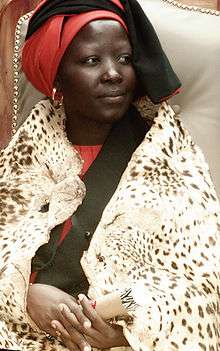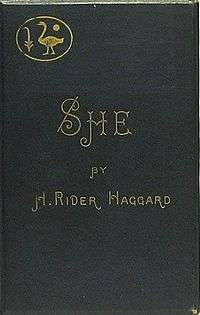Rain Queen
The Modjadji, or Rain Queen, is the hereditary queen of Balobedu, a people of the Limpopo Province of South Africa. The succession to the position of Rain Queen is matrilineal, so her eldest daughter is the heir, and males are not entitled to inherit the throne at all. The Rain Queen is believed to have special powers, including the ability to control the clouds and rainfall.
| Modjadji | |
|---|---|
| Country | South Africa |
| Founded | 1800 |
| Founder | (Modjadji I) |
| Current head | Rain Queen VII Masalanabo II Modjadji |
| Titles | Rain Queen |
| Estate(s) | Balobedu |
As of 2020 there is no ruling Rain Queen, as the previous Rain Queen died on 12 June 2005. However, a new Rain Queen is expected to be crowned when she turns 18.[1]
ROYAL PRINCESSES :
Tebogo Mokope Modjadji-Kekana (Dr )
Mokgadi Modjadji (Senior Advocate )
Modjadji Modjadji (Late )
History
There are several different stories relating to the creation and history of the Rain Queens of Balobedu. One story states that an old chief in 16th century Monomotapa (South eastern Zimbabwe), was told by his ancestors that by impregnating his daughter, Dzugundini, she would gain rain-making skills. Another story involves a scandal in the same chief's house, in which the chief's son impregnated Dzugundini. Dzugundini was held responsible and was forced to flee the village. Dzugundini ended up in Molototsi Valley, which is in the present day Balobedu Kingdom. The village she established with her loyal followers was ruled by a Mugudo, a male leader, but the peace and harmony of the village was disrupted by rivalries between different families; therefore, to pacify the land, Mugudo impregnated his own daughter in order to restore the tribe's matrilineal tradition. She gave birth to the first Rain Queen, known as Modjadji, which means: "ruler of the day".
Customs
According to custom, the Rain Queen must shun public functions, and can only communicate with her people through her male or female councillors.
Every November she presides over the annual Rainmaking ceremony at her royal compound in Khetlhakone Village.
She is not supposed to marry, but has many "wives", as they are referred to in the Balobedu language. These are not spouses in the usual sense of the word; as a queen regnant, she has the equivalent of royal court servants, or ladies-in-waiting), sent from many villages all over the Balobedu Kingdom. These wives were selected by The Queen's Royal Council and in general are from the households of the subject chiefs. This ritual of "bride giving" is strictly a form of diplomacy to ensure loyalty to the Queen.
The Rain Queen's mystical rain making powers are believed to be reflected in the lush garden which surrounds her royal compound. Surrounded by parched land, her garden contains the world's largest cycad trees which are in abundance under a spectacular rain belt. One species of cycad, the Modjadji cycad, is named after the Rain Queen.
The Rain Queen is a prominent figure in South Africa, many communities respecting her position and, historically, attempting to avoid conflict in deference thereto. Even Shaka Zulu of Zululand sent his top emissaries to ask her for her blessings. The fifth Rain Queen, Mokope Modjadji, maintained cordial relations with Nelson Mandela.
The Rain Queen has become a figure of interest, she and the royal institution becoming a significant tourist attraction contributing to the South African economy. The Rain Queen was offered an annual government civil list. The stipend was also expected to help defray the costs of preserving the cycad trees found in the Rain Queen's gardens.
Makobo Modjadji

Rain Queen Makobo Constance Modjadji VI (1978 – 12 June 2005) was the sixth in a line of the Balobedu people's Rain Queens. Makobo was crowned on 16 April 2003, at the age of 25, after the death of her predecessor and grandmother, Queen Mokope Modjadji. This made her the youngest queen in the history of the Balobedu.
Makobo was admitted into the Limpopo Medi-Clinic for an undisclosed illness on 10 June 2005 and died two days later, at the age of 27. The official cause of death was listed as chronic meningitis. She is survived by a son, Prince Lekukela Hex(b. 1997), and a daughter, Princess Masalanabo (b. February 2005).
Succession
The Rain Queen's official mates are chosen by the Royal Council, so that all of her children will be of dynastic status, from which future Rain Queens may descend. However, the Rain Queens are not expected to remain in exclusive relations with these partners. In the past, the Rain Queen was allowed to have children only by her close relatives.
Perhaps uniquely, the Balobedu crown descends according to matrilineal primogeniture: her eldest daughter is always her successor, so the title of Rain Queen is normally passed from mother to daughter. It is said that she ingests poison when she is near death so that her daughter will assume the crown more quickly. Lately, however, many traditions have been abandoned, influenced by Christian missionaries. Because Makobo's daughter, Princess Masalanabo, was fathered by a commoner, traditionalists are not likely to accept her as the rightful successor to the throne. Therefore, there are worries that the 400-year-old Rain Queen dynasty may be coming to an end. No new Rain Queen has been enthroned since Makobo died.
Makobo's brother Prince Mpapatla has been designated regent for Masalanabo. However, Mpapatla has a daughter by his cousin, a woman from the royal Modjadji line, and a group of members of the Royal Council has indicated a preference for Mpapatla's daughter to succeed as Rain Queen. Mpapatla, however, has insisted that his late sister's daughter, Princess Masalanabo, will be enthroned as the queen when she turns 18.[2][3]
A male branch of the extended royal clan has also petitioned the South African president to restore the male line of the Balobedu royal house, which reigned before 1800. This entreaty is considered unlikely to be granted, inasmuch as the Rain Queen heritage is recognised as a national cultural legacy and interest in it has stimulated significant tourist trade.
Rain Queens
- Rain Queen I Maselekwane Modjadji (1800–1854)
- Rain Queen II Masalanabo I Modjadji (1854–1894)
- Rain Queen III Khesetoane Modjadji (1895–1959)
- Rain Queen IV Makoma Modjadji (1959–1980)
- Rain Queen V Mokope Modjadji (1981–2001)
- Rain Queen VI Makobo Modjadji (2003–2005)
- Prince Regent Mpapada Modjadji (2007-2018)
In popular culture

The second Rain Queen, Masalanabo Modjadji is said to have been the inspiration for H. Rider Haggard's novel She: A History of Adventure.
The Marvel comics character Storm is a fictional descendant of the dynasty that produces the Rain Queens through the line of the Sorceress Supreme Ashake.
See also
References: Tebogo Mokope Modjadji-Kekana
- Njanji, Susan. "SA's pre-teen queen with 'rainmaking' powers", The Citizen (November 6, 2017).
- "Rain Queen finally recognised". Sowetan LIVE. Retrieved 2016-08-19.
- Bongani Nkosi (2016-05-30). "State recognises the Rain Queen". Times LIVE. Retrieved 2016-08-19.
External links
- Rain Queen customs and history, from a South African website for the Ikageng Community Empowerment of Tzaneen
- Rain Queen customs, from a commercial website promoting "very small-scale, locally produced, low-impact Ecotours"
- "The Balobedu of Modjadji".
- Rain Queens of Africa and other Female Leadership traditions
- The Sacred Forest of the Department
- The Lobedu: A North Sotho Tribe
There's a Foundation and Awards founded by : Dr Tebogo Mokope Modjadji-Kekana ( 2015......)